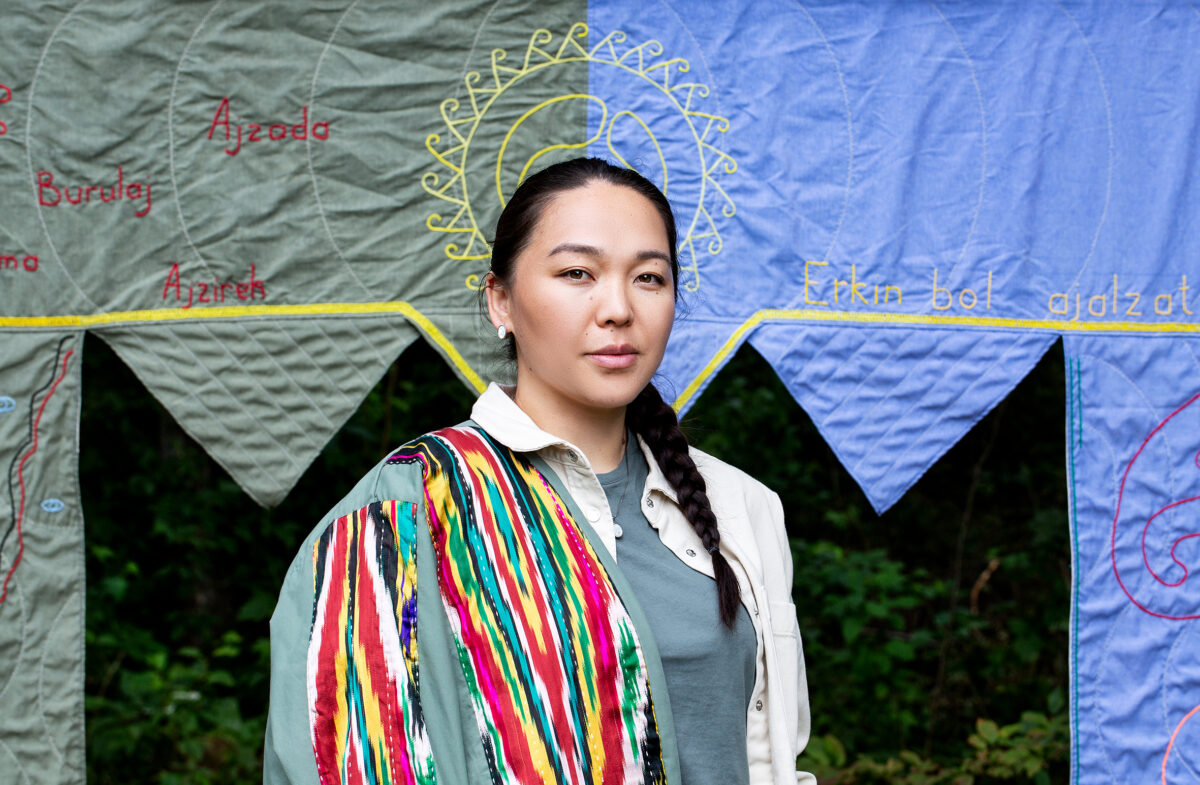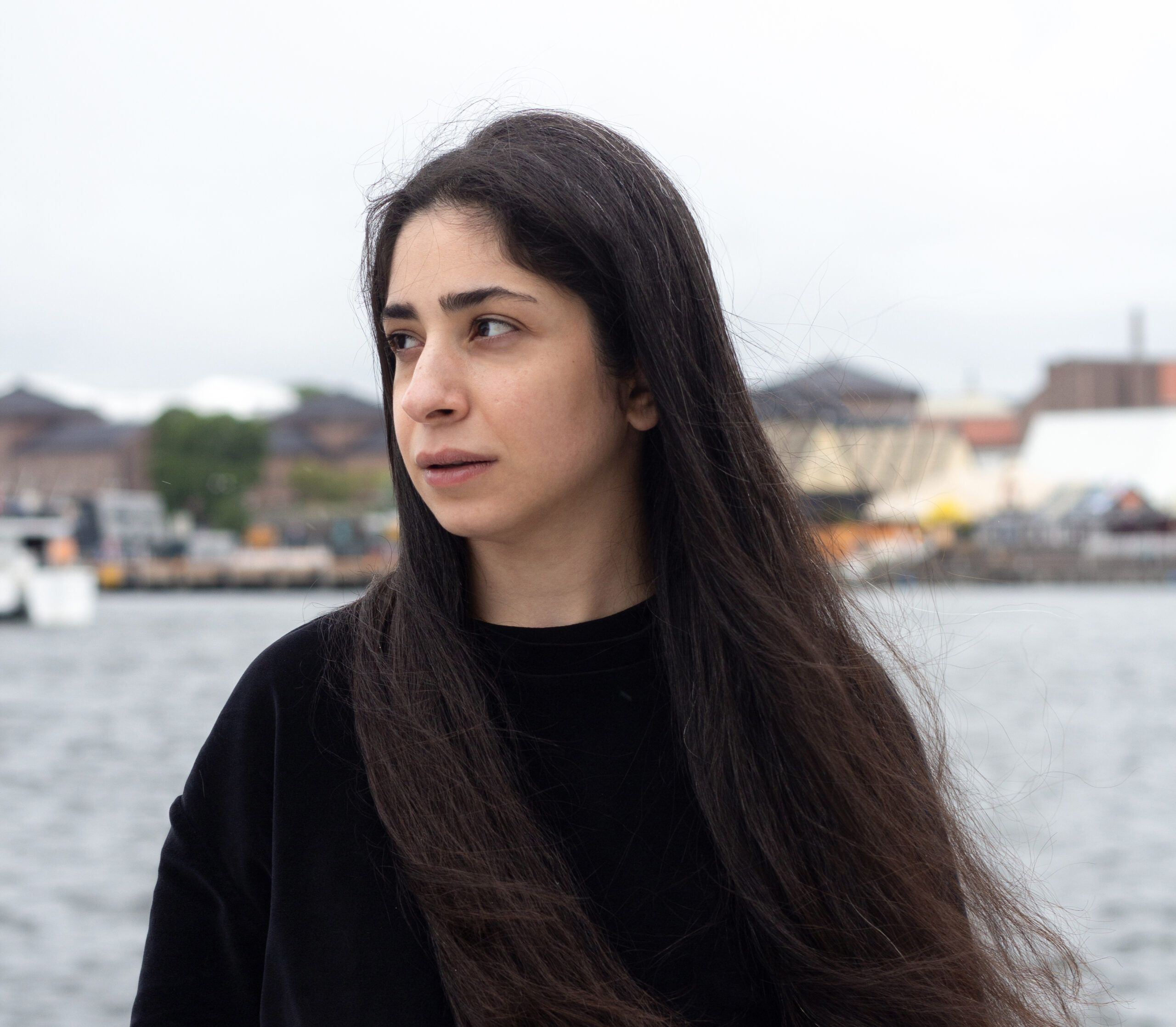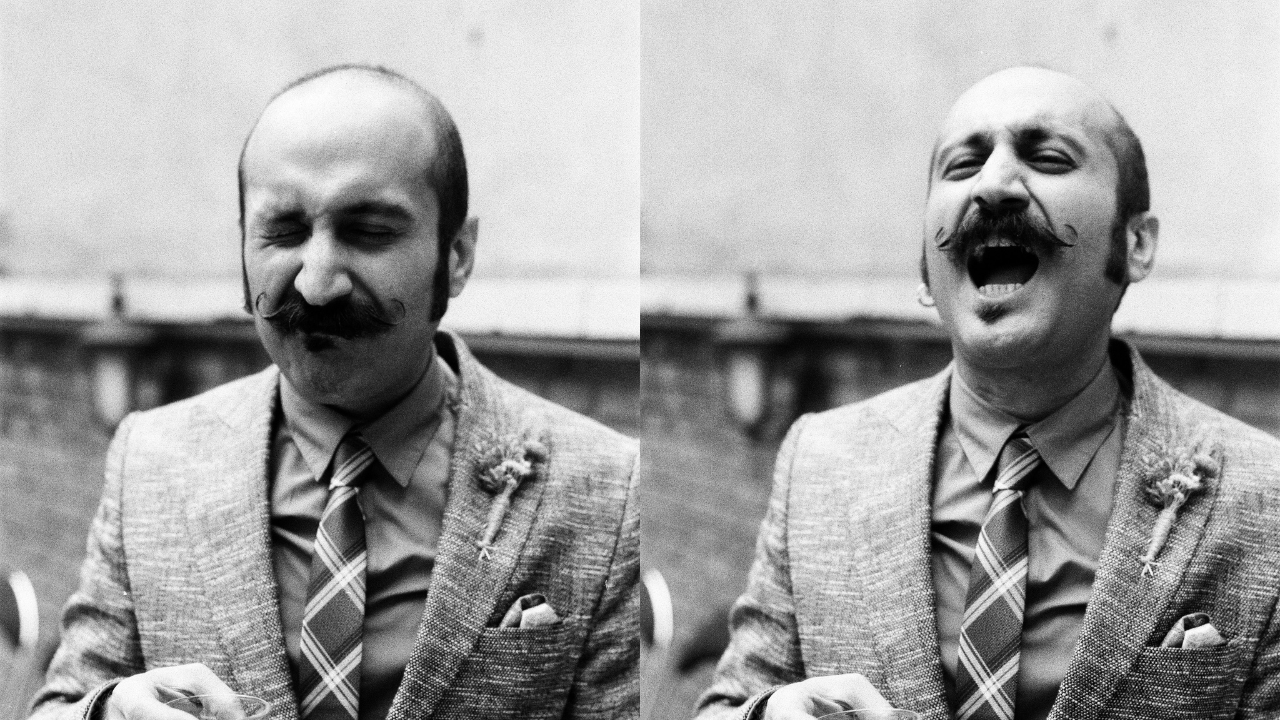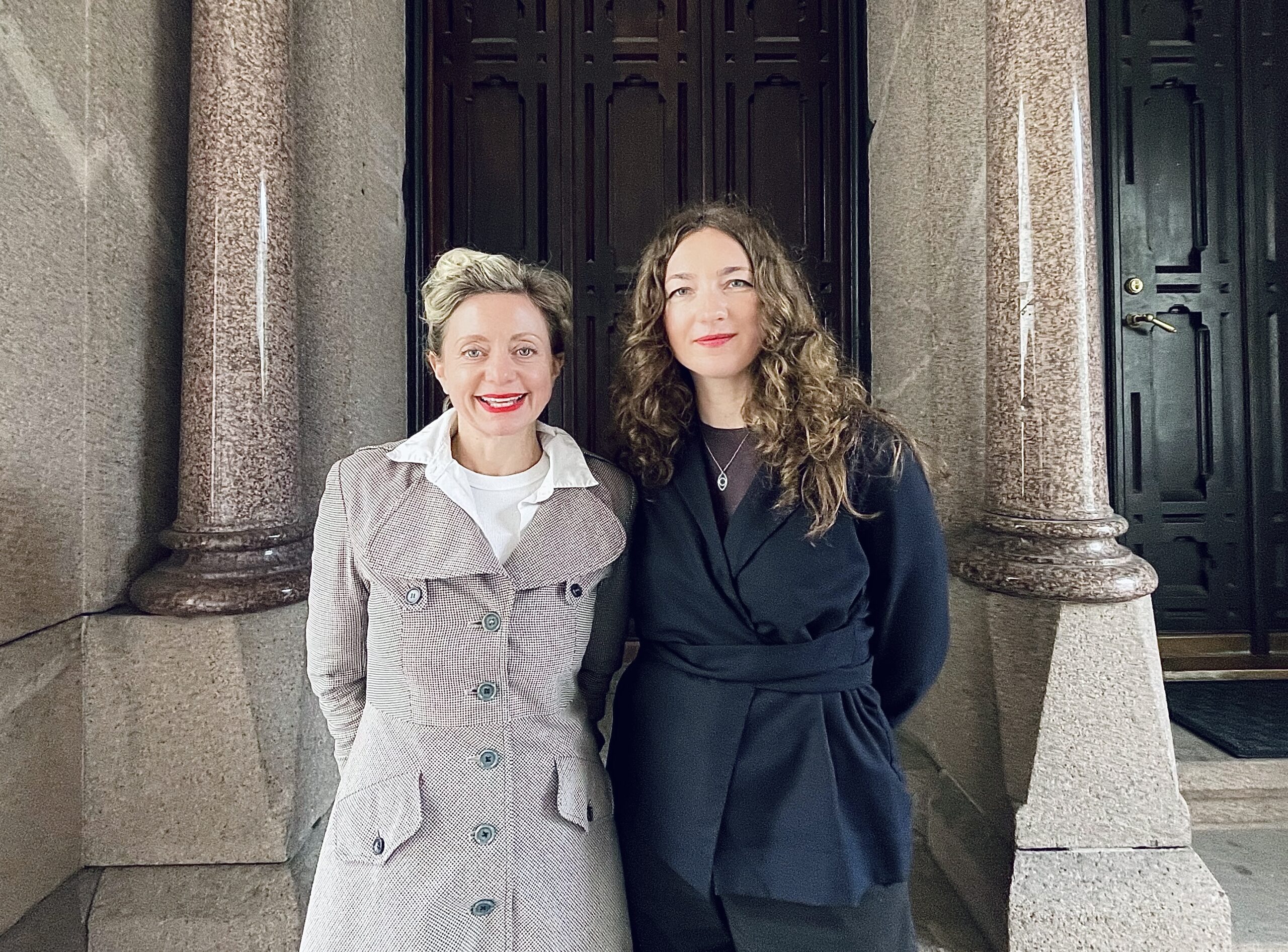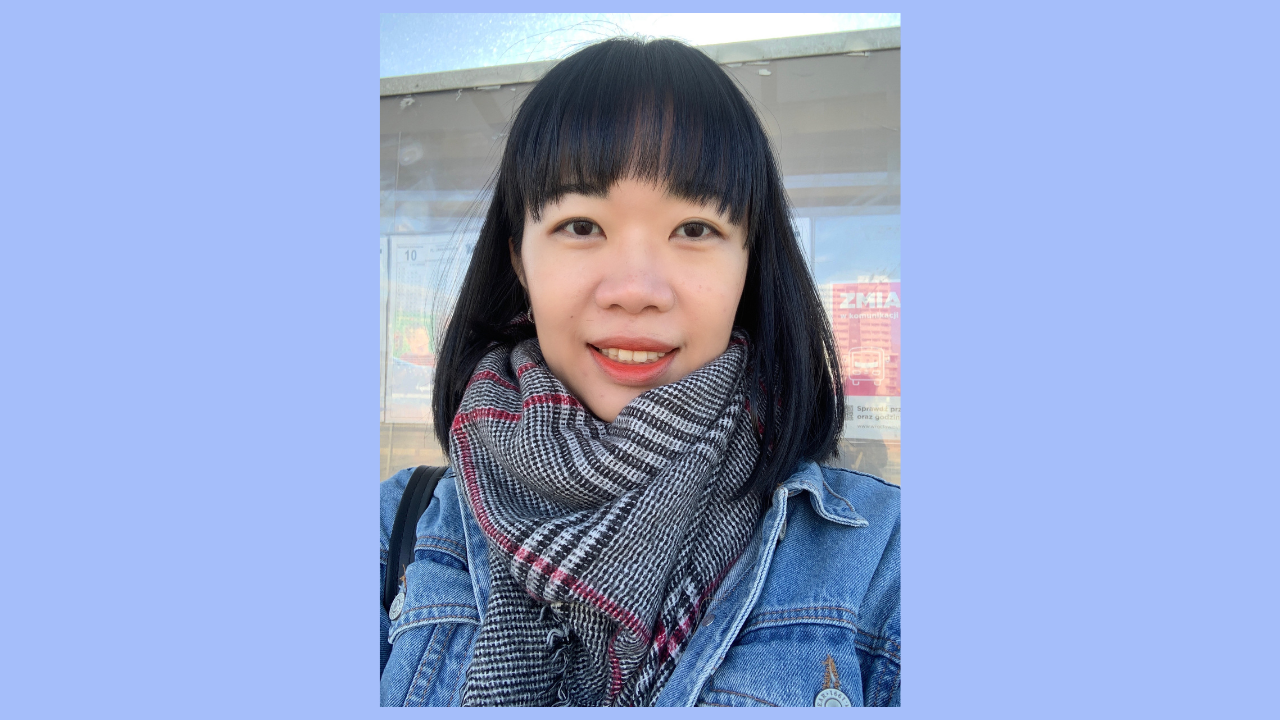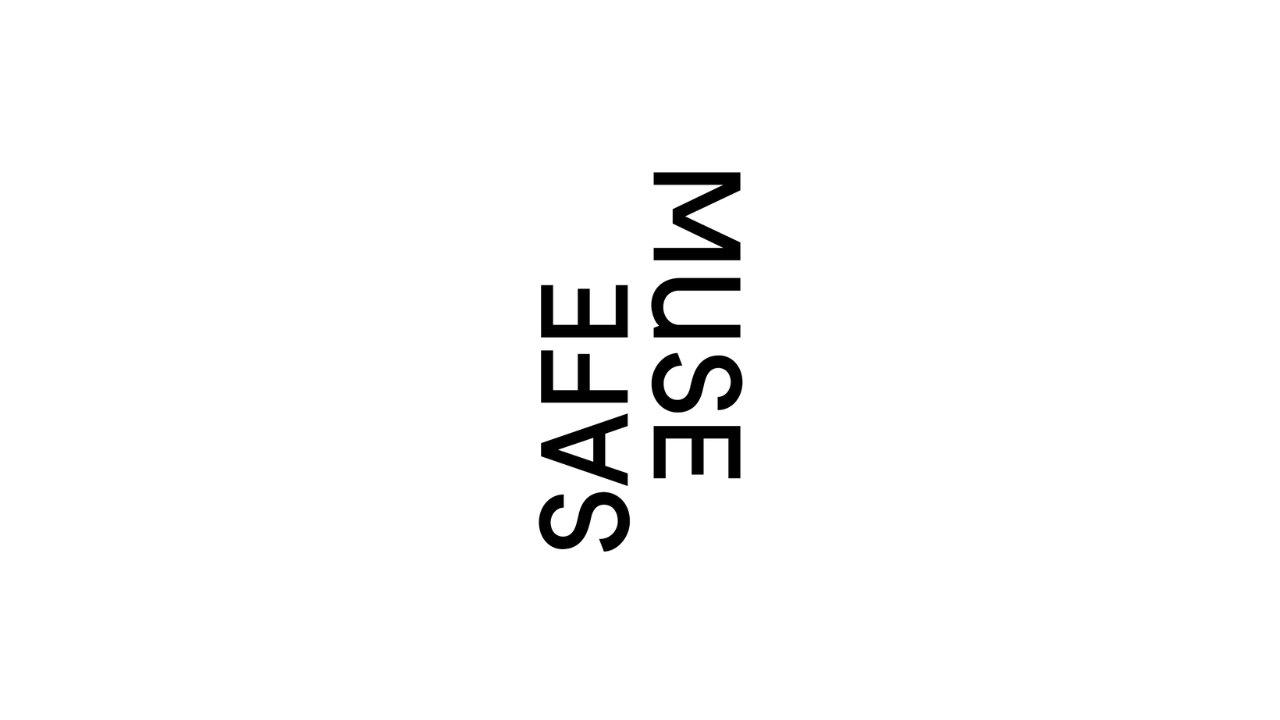Nurperi Orunbaeva: Decolonising the Self through Artistic Practice and Reimagining Ancestral Heritage
Written by Aliona Pazdniakova

Nurperi Orunbaeva (b. 1994) is a multidisciplinary artist, curator, art activist, and advocate for women’s rights based in Bishkek, Kyrgyzstan. Her artistic practice encompasses a diverse range of media, techniques, and scales, including wall painting, painting, graphics, sculpture, installations, textiles, and more. Nurperi’s artistic approach integrates a conceptual framework with a direct statement and bold expression. Her unwavering commitment to women’s rights, the historical legacy of her nation, and its cultural heritage serve as the foundation for her artistic ideas. In many of her works, she addresses the experiences of women subjected to suppression and violence, yet they persist in their pursuit of light. Nurperi delves into the past, reflecting on the darkest chapters in her nation’s history. Through her installations, she juxtaposes the past and present, presenting them in a contemporary context.
From June 2025, Nurperi is an artist in residence at Hvitsten Art Haven. During this period, she anticipates making new connections and friendships within the Norwegian art world, as she firmly believes in the transformative power of community in combating oppressive systems. She emphasises, that only together can we make a meaningful change. Peri seeks a break from her customary routine and the daily challenges of securing employment and pursuing small projects. She appreciates the opportunity to simply engage in her artistic practice without the constraints of risk, judgment, or persecution. She enjoys visiting Norwegian museums and galleries, as art and history are her profound passions and driving forces in life. The opportunity of participating in diverse cultural events and exhibiting her work fills Peri with immense joy.
Art as an act of courage
“I dedicate my life to culture and art” – this stand-out sentence was written by Peri in her residency application.
Peri’s journey into the art world is a captivating story. Initially pursuing a career in medicine, she successfully completed her studies and worked as a dentist for a period following her graduation. However, the tumultuous years of 2019 – 2020, marked by the pandemic, catalysed a profound transformation in her life. Dramatic events transpired in Peri’s life and the lives of her friends and family, all the injustices of society made her realise that the oppressed position of women was the theme she cared most about. This, coupled with the feeling that she did not want to be a dentist but rather was compelled to fulfil her family’s expectations and pursue a “proper” profession, led Peri to make a radical decision. On January 1, 2021, she resigned from her medical career and joined her community as an artist, immediately engaging herself in all possible artistic activities. However, she describes this decision as natural and light-hearted, as being an artist had always been the dream of her life.
– All my childhood and youth, I closely observed my grandparents, parents, and all the relatives, witnessing their proficiency in various crafts. It was inevitable that I would inherit these skills and develop a knack for them. My keen eye, sharp memory, inventiveness, and innate sense of justice have contributed to the development of my conceptual vision. I became a repository of not only my personal history but also the collective history of my family and nation. Thanks to a long search for myself, I picked up a lot of handcrafts and techniques. I strive to apply these acquired knowledge effectively in my artistic practice, using them to tell the important stories”, Peri tells.
Art for Peri is deeply intertwined with the concept of freedom of expression, which she perceives as a fundamental capacity and the courage to create. This profound understanding of art has been shaped and reinforced by her life experiences and personal growth. Throughout her life, she has been subjected to various restrictions and pressures stemming from propaganda and the rigid norms of patriarchal society.
Kyzyl Kamchy, Femicide, Not Jewellery, Sanzhyra, Mountains of Sorrow, Peris – in her works, Peri explores themes of violence, memory and identity. Through her artistic expression and craftsmanship, she weaves a solid narrative comprising various interweaved pieces.
– My area of interest encloses both personal motivation and social engagement. Occasionally, I experience an overwhelming desire to express my views, and certain installations serve as a medium that helps to do it. At other times, I am deeply concerned about the state of my society. While I´m inside my community where everyone shares similar values and interests, I remain oblivious to the rough things that surround us. However, when I´m unexpectedly outside of my environment, on my way home or during a walk, I suddenly realise how ignorant and evildoing our society is.
I derive pleasure from experimentation, as each new idea presents a challenge that I enjoy solving. I find satisfaction in this process. While some facts from the past or present serve as my starting point, I often deviate from this factual material to create a work based on my intuition and interpretation. This process adds an extra layer of significance and conceptualization to my works, Peri reflects.
“I would kill her anyway”
Kyrgyzstan, a country rarely mentioned in our local news channels, is experiencing a flourishing authoritarian regime that particularly affects vulnerable and minority groups, including women, LGBTQ+ community, and artists who have bravely spoken out for women’s and queer´s rights. At home, Peri and her colleagues face numerous challenges. They struggle to secure financial support, working space and exposure for their projects, while simultaneously working under the constant threat of censorship and persecution. Discussing women’s rights is not appreciated by the patriarchal society, and mentioning the struggles of the queer community is considered LGBTQ+ propaganda, leading to potential repressions, fines and arrests.
In one of her first works titled “Kyzyl Kamchy”, Peri addresses the subject of domestic violence. She created this piece in response to the pandemic, which brought to light an alarming rise in domestic violence cases. The title “Kyzyl Kamchy” translates from Kyrgyz as “Red Whip”, derived from the blood of women who have been beaten by their husbands.
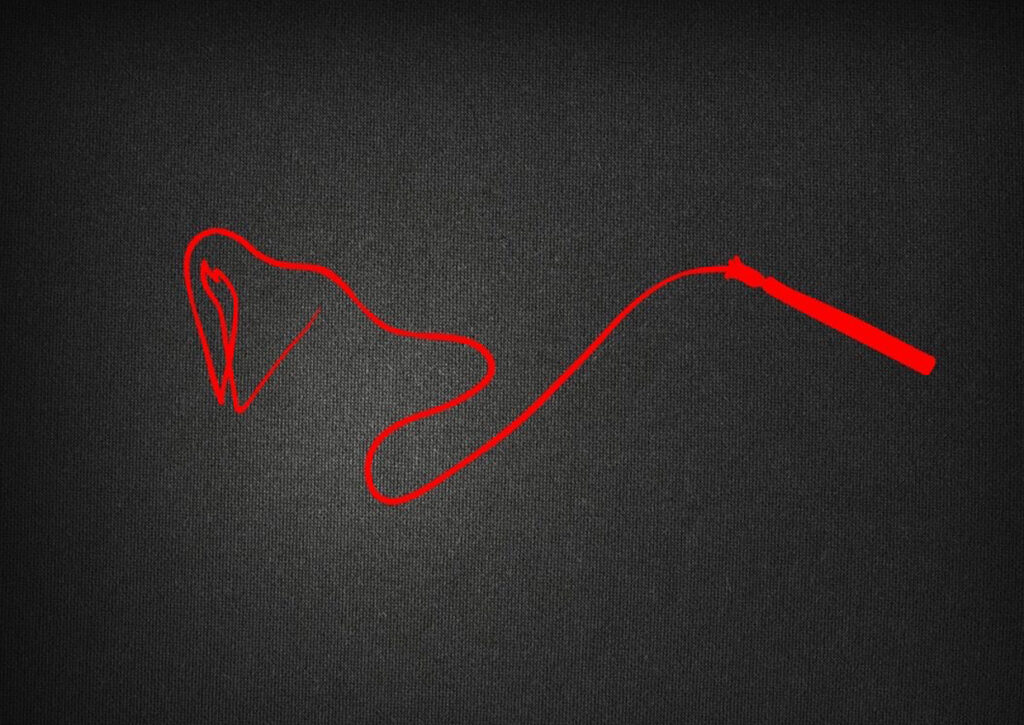
I intended to make this artwork in a manner that would be easily comprehensible and recognisable by all Kyrgyz people and everyone who encounter it. I wanted to express the horror of female violence by a single thin line. Each red whip tells a story of pain, survival, or death of a woman. The statistics of female violence is horrific. There is a wish to collect all existing red whips and throw them out of our lives, so that we can finally release our fears and exit this hell of violence.
— Nurperi Orunbaeva
In her next work, Peri expanded the scope of this topic, creating an installation titled “Femicide”.
The installation comprises 762 female figures. It is based on a study conducted in Kyrgyzstan that documented 762 criminal cases categorised under the article “Murder” involving the killing of women. Notably, most of these murders were perpetrated by men, with 75% of cases involving individuals who knew the victims, such as intimate partners, relatives, or friends. This alarming and silent data quantifies the magnitude of the tragedy, and the profound sense of vulnerability experienced by women, prompting Peri to create this work in a manner that aims to evoke an understanding of the scale of horror within her society.
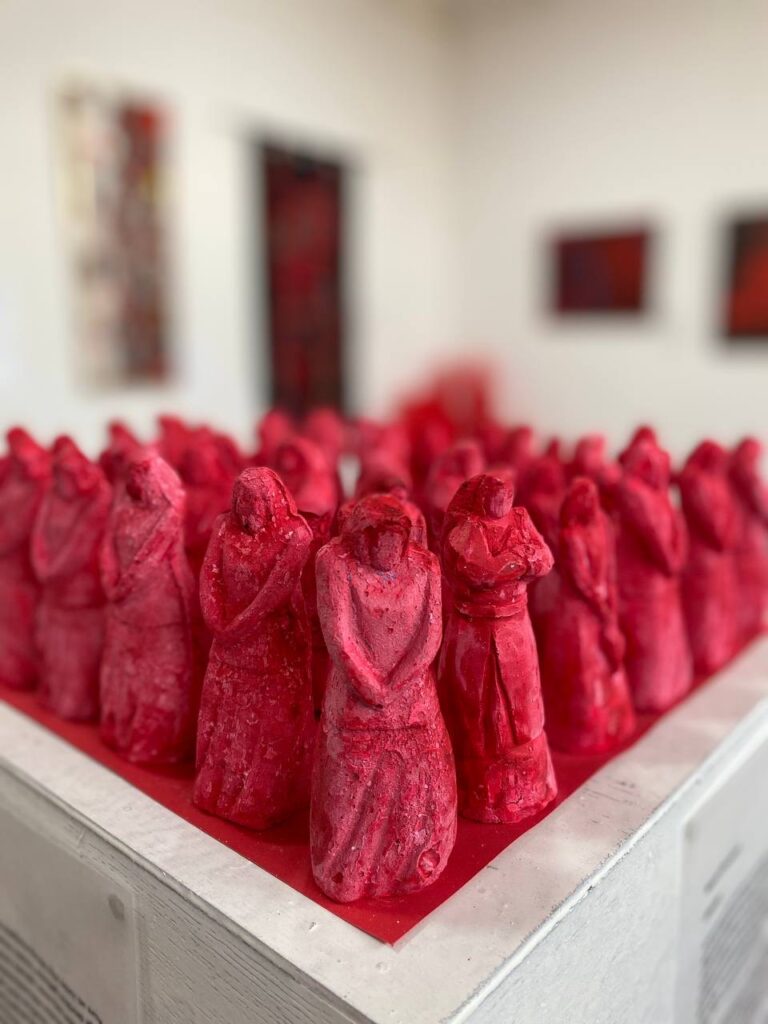
The idea of this installation originated from Peri’s encounter with a research paper “I would kill her anyway,” authored by KLOOP, an organisation prohibited in Kyrgyzstan.
– The fact that there is violence is known everywhere, but not everyone admits this. I have personally witnessed it within my own family, among my relatives, neighbours, and the families of my friends, all around. Upon reading the research, I was deeply moved, particularly by the fact that men often failed to comprehend the gravity of their actions, overlooking domestic violence as an acceptable norm. Some of them had been planning to kill their wives for several months, and many expressed no regrets for their crimes. The pervasive nature of this violence throughout our lives and the lack of understanding of its wrongfulness have left an indelible mark on us all, perpetuating a sense of injustice. I know so many stories of femicide. They tortured me from inside until I began to talk about them through my works. This is my form of fight for the lives and liberation of women, us, Peri emphasises.
Revisiting traditions
Kyrgyz cultural heritage and traditions, which both characterise and affect Kyrgyz society, hold a significant place in Peri´s works. The controversial nature of many of the traditions, shaped within the context of male dominance, often serves as a catalyst for Peri´s artistic process. She makes an example:
– For instance, there exists a tradition known as Ala Kachuu, which involves the kidnapping of young women with the intention of marrying them. This practice often entails severe violence, confinement, and rape. The abducted girl is left hopeless, this is the end for her, as there is no chance to escape the captor’s house, due to the shame, as it will leave her with a “scar” that would haunt her and her family for the rest of her life. In certain cases, the abducted girl may remain married to her captor for the entirety of her life, while in other instances, the marriage may dissolve within a single year.
“Not Jewellery” installation by Peri is a work that draws inspiration from traditional Kyrgyz crafts and serves as a commentary on the ambivalent nature of patriarchal traditions in Kyrgyz society. While many Kyrgyz traditions are beautiful, solid, and rich, they often play a role of a camouflage for the promotion of patriarchal values. These traditions frequently marginalise female roles, labour, and restrict women’s rights and freedom. These rigid traditions do not decorate society but rather highlight its weakness and impediments to development. Each ring of jewellery cast from lead in this installation is referred to “uyat,” which symbolises the burdensome legacy of patriarchal values that have been passed down through time.

All actions, statements, and events that contain malevolent intentions to humiliate, insult, or kill women do not decorate; this is the ugliness of society.
— Nurperi Orunbaeva
In her work “Sanzhyra” Peri refers to the genealogical book, an ancient spiritual heritage of the Kyrgyz people, that was disseminated orally from generation to generation. This knowledge serves as a means of familiarising individuals with their ancestors and relatives, with the primary objective of preventing incest. In her installation, Peri highlights the absence of female names in her family’s lineage, a genealogical tree that disregards their vital roles and denies their contributions. Through her work, Peri seeks to reclaim the place and recognition of these women.
– During my childhood, we were instructed to become familiar with the names of our relatives and to trace our family lineage predominantly on the paternal side (we were required to know 7 names of our paternal side), where female names were notably absent. My sisters and I frequently questioned this practice, as we were unable to find the names of our grandmothers and mother. We experienced a strong sense of injustice and decided to write our names in the book after our father’s names – it was so much fun, Peri recalls.
In Kyrgyz culture, Sanzhyra is often depicted as a tree. In her own female Sanzhyra, Peri employs a metaphor of tree roots, creating a network of women that symbolises the fundamental origin of any genealogy. Alongside large, white roots resembling long white braids of her grandmothers, there are faces of her colleagues and friends, women from MoFA+, connecting several generations of women. This installation effectively weaves together the subtle presence of heroic female figures of the past with contemporary activists fighting for female rights, making it a vibrant representation of the vital force that sustains our lives.
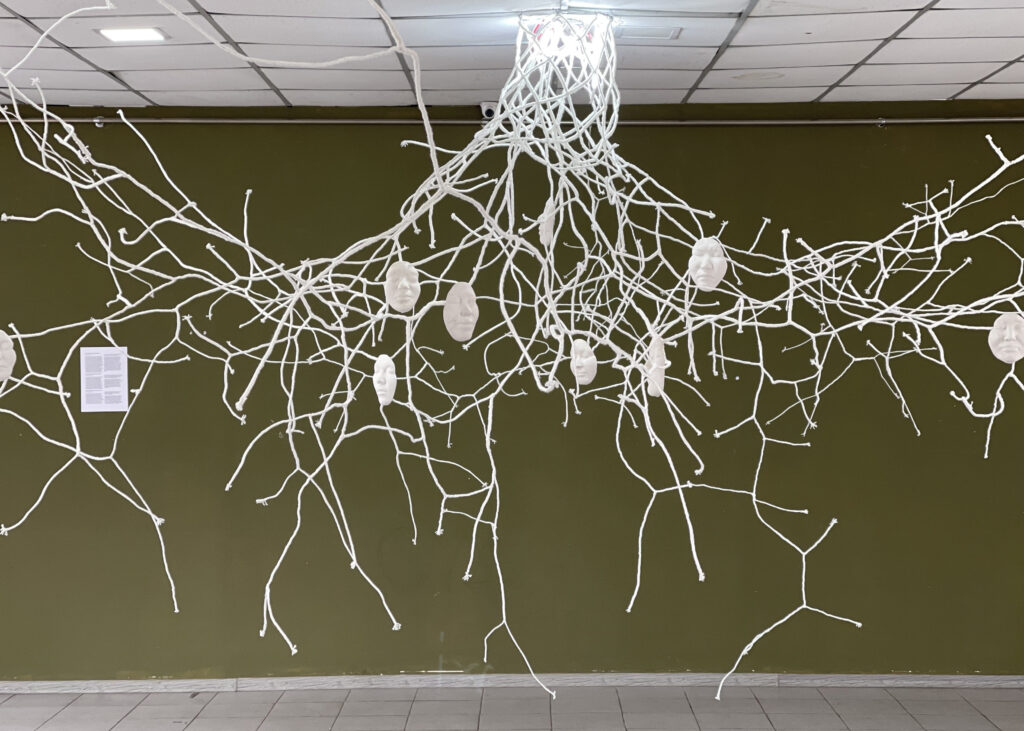
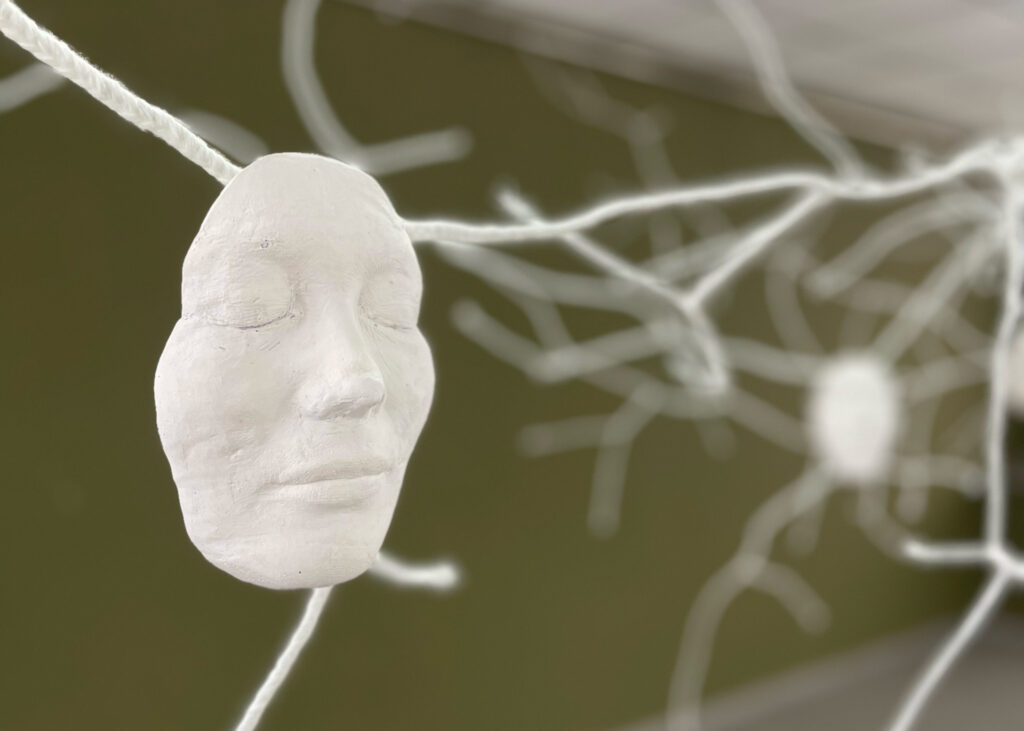
I believe that the invisible role of women is like these roots: without them the tree would not have sprouted so huge! I deeply respect and actively explore the female lineage in my family history. It’s very important to me. I experience an intense sense of warmth and deep connection to my mother’s line, when I´m working. I perceive my role as a means of honouring women in our genealogy and visualising the profound bond between mothers and women in general.
— Nurperi Orunbaeva
Reclaiming the self
In patriarchal societies, women often grapple with a profound and shared identity crisis stemming from their oppressed position. While acknowledging this injustice, many women succumb to apathy, dismissing any potential for change and ultimately failing to fully embrace their authentic selves. Those who dare to stand up, raise their voices and try to challenge these suppressed conditions encounter an abyss as they search for who they are, a question that was suppressed during their childhood and youth, denying them the opportunity for exploration.
In her work titled “Peris”, Peri initiates a journey of self-discovery by simply gazing into the mirror and drawing what she sees. As she recognises that each time she engages in this process, she discovers a new version of herself, she decides to dedicate herself to this endeavour without rushing it. Her intention extends beyond mere identity exploration; she yearns to embrace this transformative journey with joy and find a sense of self-return, seeking for re-connection with the authentic self that was once taken from her and remains elusive.
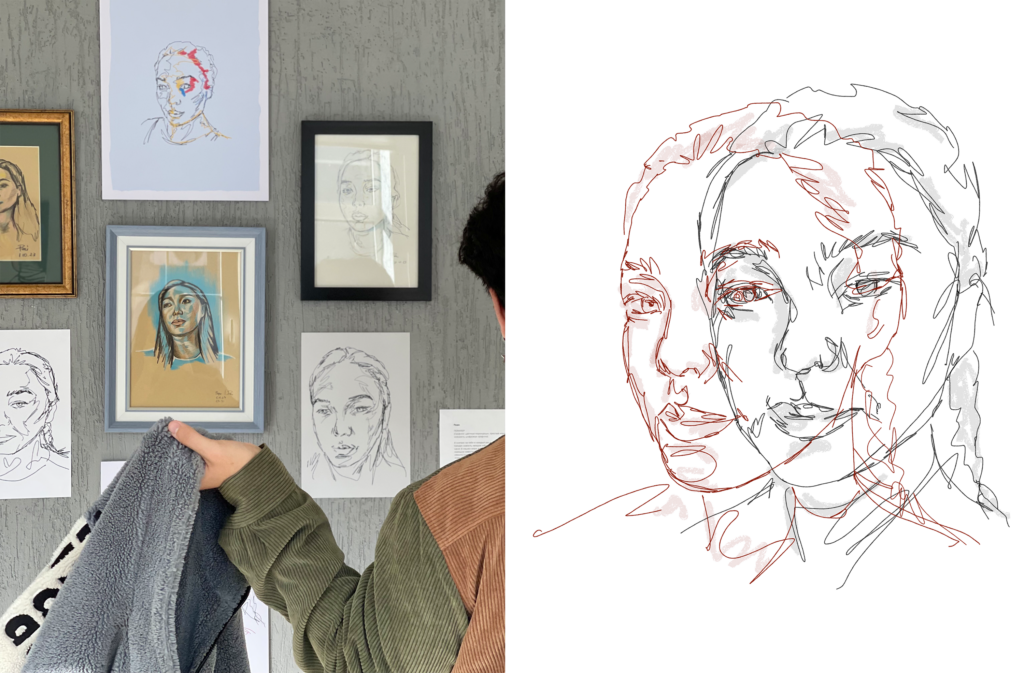
– During the pandemic my ground was severely shaken, I had to save myself but also my friends: I had to claim their salaries, deal with threats and blackmail, work tirelessly, and strive to survive. Additionally, I had to provide for my entire family, who were facing significant hardships. One day, as I was walking through one of the corridors, I noticed a silhouette that was moving at the same slow pace as I was. I stopped for a moment and then realised that the silhouette was my reflection in the mirror. I did not recognise myself: my eyes, hair, and features were all foreign to me.
At the age of 26, with my parents still alive, I had transformed into an exhausted, shapeless, dull, and grumpy girl. I had never been able to express myself because I had to be a good girl. No questions about the identity, relationships, or personal development. Then, I began to wonder when this all had started and how it had gone so wrong. I realised that for a long time ago I had been lost in siblings and all my responsibilities.
I´m the first child of my parents, in addition, I´m a daughter. This means that all my life I had to be a third parent, not only for my siblings, but also for my parents. I was never allowed to be a child.
Since my early childhood, as a first-year schoolgirl, I have memories of coming back home after classes and washing asses of my sisters, then cooking food to them, then cleaning the house. This lasted for a very long time. I separated with my parents when I was 29, and only since then did I start to live my own life, I began to take care of myself, invest in myself, listen to myself and love myself, Peri shares.
The driving force of the community
During the Covid, Peri realised that she is not alone in her process and that she was part of a supportive community of women facing similar challenges and seeking solutions. In 2022, she joined MoFA+, where she has progressed through various roles, including volunteer, artist, and curator.
The Central Asian Museum of Feminist and Queer Art (MoFA+) was established in 2019 following the successful exhibition “Femminale”.
– The first Feminnale was a groundbreaking event that garnered substantial attention and resonance. It appears everyone got to know about the exhibition. The public was shocked, and authorities were offended, leading to their immediate attack on the organisers. Altyn Kapalova (one of the MoFA´s founders) suffered greatly from this. Although I was not present at the exhibition, I closely followed the unfolding events on social media, witnessing a real hunt that has begun from all possible sides.
Since the legalisation of the “Propaganda of LGBT” law, our partners and investors (who were relatively few) have stopped their collaboration with MoFA+. We were ordered to cease discussing women’s rights. We have lost our studio and the museum´s art archive had to be relocated and stored at Altyn´s house. Our salaries were dependent on fees generated from participating in projects, and despite our attempts to operate underground, the combination of financial constraints and prohibitions rendered the museum’s functioning impossible. As a result, we are currently taking a so called “creative vacation”, Peri explains.
During the first promising years of MoFA´s life, Peri actively participated in numerous projects, engaging in various creative endeavours such as making artworks, helping with photo and video documentation, taking part in and curating exhibitions and Buddhist art expeditions, as well as art bicycle rides.
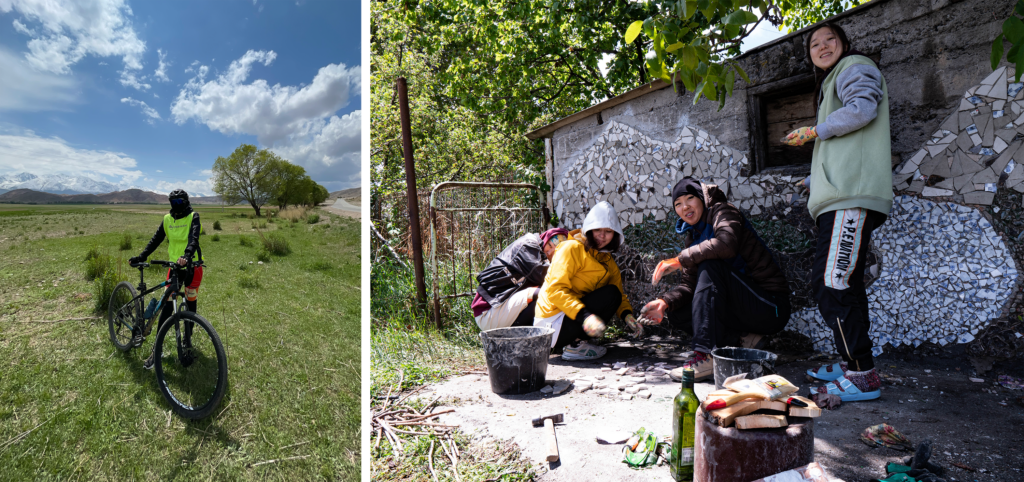
– To organise art bicycle rides for female artists, feminists and women supporting other women and the queer community, was the big dream of Altyn.
Ones she made a research based on a questionnaire made to fellow female artists where she asked, amongst other things: “Are you free?”, where the answers were predominantly “yes”. However a subsequent question “Whom do you usually ask for the allowance to meet your friends?” was followed by the replies: “My husband, or my father, or my brother”.
The purpose of the art bicycle ride was to demonstrate to women in Kyrgyzstan and Central Asia that we truly possess freedom of movement, Peri describes.
The bicycle ride around lake Ysyk-Köl, which took seven days, has already occurred twice in 2022 and 2023. Peri recounts her exhaustion during the first attempt, describing herself as ambitious, passionate, but very inexperienced as a cyclist.
– During the first ride my face flushed a vibrant red due to all the intense wind and hardcore cycling, and only the strong spirits could sometimes help, Peri recalls, laughing.
Art as a form of resistance and empowerment
However, in the second ride, she had already assumed the roles of organiser and curator. During this ride, Peri also managed to create an installation titled “Mountains of Sorrow”, in which she reflects on the tragic events in the history of her nation.
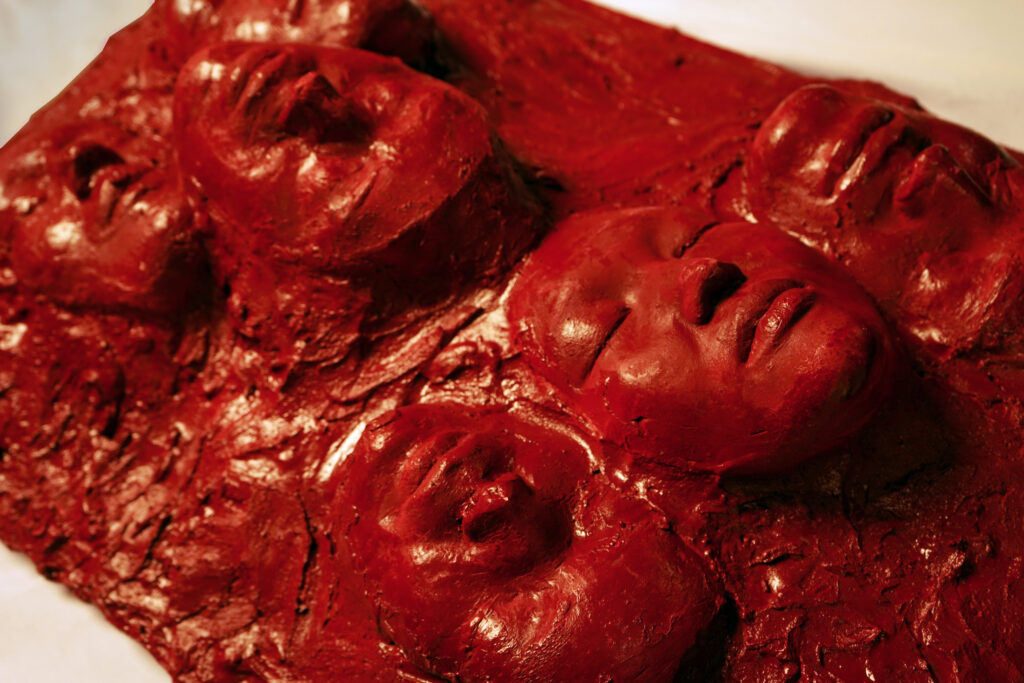
This ride delves into the tragic history of the Ürkün, a horrific act of ethnic cleansing perpetrated by the Russian Empire in 1916. During this campaign, approximately 40 to 60% of the Northern Kyrgyz population was systematically murdered by Russian forces. Additionally, vast territories were colonised, and numerous animals and treasures were plundered. The genocide compelled countless individuals to flee to China in search of asylum.
“Ürkün” is derived from the Kyrgyz verb “ürküü”, which directly translates to “to shy away in fear” or “to run in panic and recklessly from danger.”
– This word is applicable only while talking about animals, not humans. We thought, it precisely describes the genocide and persecutions committed by the Russian Empire on the territories of Kyrgyzstan. We were collecting the stories of families affected by this horrific mass murder, survivors who returned from China. One such story was recounted by the grandchild of the village major, who vividly described how his grandfather saved his village, but not without the greater cost. He has shown us a mountain that was covered in dead bodies. In my own work, I refer to this story as I wanted to re-create this bloody mountain, which many were unable to climb over, Peri tells.
During Peri’s artist talk in Hvitsten, she emphasised that her artistic practice, as well as those of other women in MoFA+, serves as a form of resistance against the oppressive structures of patriarchal society and colonialism. Their primary objective is to reclaim their personal identities and the identities of their nations, which have been stolen from them.
In her artistic activity, Peri bravely and boldly takes a space, presenting her own unique perspective on both her local social and global contexts.
For the Hvitsten Salon 2025, she crafted a textile art piece entitled “My Heritage”. This work is rooted in the Tushtuk tradition, a unique inheritance passed down from a mother to her daughter. Traditionally, every mother begins preparing her tushtuk for the daughter upon her birth. It is scrupulously handmade from intricate patterns imbued with symbolic meanings, often interwoven with prayers, wishes, and aspirations for a prosperous and fulfilling marriage for her daughter.
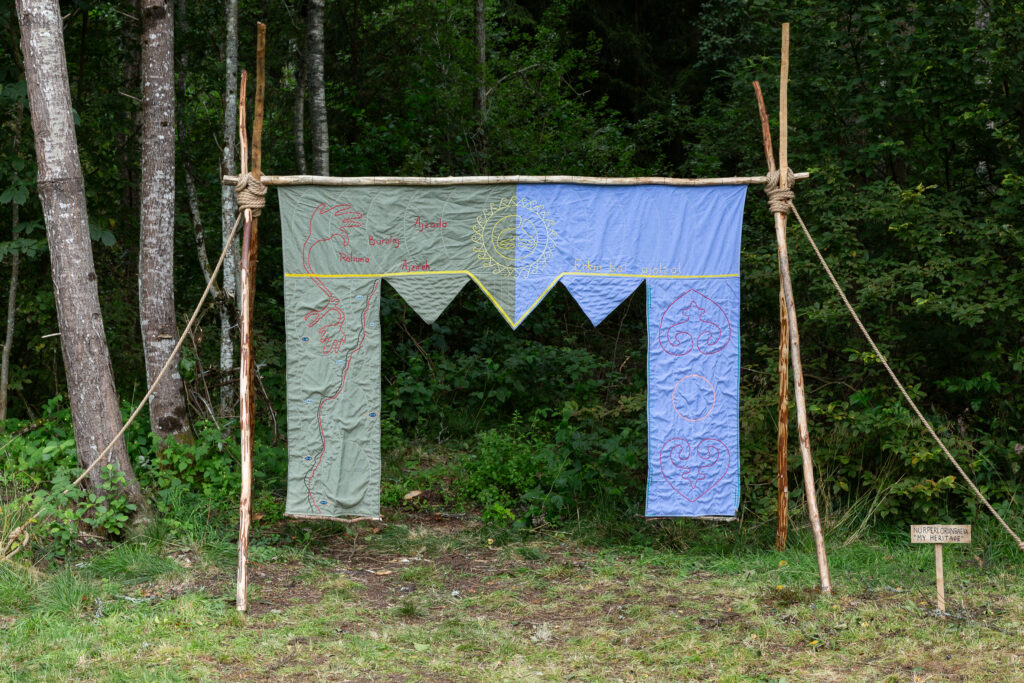

Embracing the tradition while asserting her own interpretation, Peri makes her personal version of tushtuk that she dedicates to all the daughters of the world. She highlights:
– My work is a legacy for all the daughters of the world. It serves as a testament to the empowerment of women, inspiring generations to break free from the constraints of traditional roles. It is not an expectation to be passive and obedient wives, nor is it a demand to silence our voices. Instead, it is a call to embrace our true selves and seek liberation from the oppressive structures imposed by patriarchal societies.
In addition to the names of victims of femicide and her personal choice of symbols, on the front of her tushtuk, Peri embroiders the sole wish that is both a spell, a mantra, and a call to action: Erkin bol ajalzat! – Be free, women!
Menu Close Safemuse About Us What we do Our five pillars Our history Who we are Our members Media resources Contact Us News Safe residencies Residency programme Oslo Art Haven Hvitsten Art Haven How to apply Projects Safe Havens Conference Women’s network MoFA+ collaboration Salong på Salongen Artistic mobility Artistic Freedom Week LIDIO .SAFE Artists
About Us What we do Our five pillars Our history Who we are Our members Media resources Contact Us News Safe residencies Residency programme Oslo Art Haven Hvitsten Art Haven How to apply Projects Safe Havens Conference Women’s network MoFA+ collaboration Salong på Salongen Artistic mobility Artistic Freedom Week LIDIO .SAFE Artists
About Us What we do Our five pillars Our history Who we are Our members Media resources Contact Us News Safe residencies Residency programme Oslo Art Haven Hvitsten Art Haven How to apply Projects Safe Havens Conference Women’s network MoFA+ collaboration Salong på Salongen Artistic mobility Artistic Freedom Week LIDIO .SAFE Artists ...
Menu Close Safemuse About Us What we do Our five pillars Our history Who we are Our members Media resources Contact Us News Safe residencies Residency programme Oslo Art Haven Hvitsten Art Haven How to apply Projects Safe Havens Conference Women’s network MoFA+ collaboration Salong på Salongen Artistic mobility Artistic Freedom Week LIDIO .SAFE Artists
About Us What we do Our five pillars Our history Who we are Our members Media resources Contact Us News Safe residencies Residency programme Oslo Art Haven Hvitsten Art Haven How to apply Projects Safe Havens Conference Women’s network MoFA+ collaboration Salong på Salongen Artistic mobility Artistic Freedom Week LIDIO .SAFE Artists
About Us What we do Our five pillars Our history Who we are Our members Media resources Contact Us News Safe residencies Residency programme Oslo Art Haven Hvitsten Art Haven How to apply Projects Safe Havens Conference Women’s network MoFA+ collaboration Salong på Salongen Artistic mobility Artistic Freedom Week LIDIO .SAFE Artists ...
Menu Close Safemuse About Us What we do Our five pillars Our history Who we are Our members Media resources Contact Us News Safe residencies Residency programme Oslo Art Haven Hvitsten Art Haven How to apply Projects Safe Havens Conference Women’s network MoFA+ collaboration Salong på Salongen Artistic mobility Artistic Freedom Week LIDIO .SAFE Artists
About Us What we do Our five pillars Our history Who we are Our members Media resources Contact Us News Safe residencies Residency programme Oslo Art Haven Hvitsten Art Haven How to apply Projects Safe Havens Conference Women’s network MoFA+ collaboration Salong på Salongen Artistic mobility Artistic Freedom Week LIDIO .SAFE Artists
About Us What we do Our five pillars Our history Who we are Our members Media resources Contact Us News Safe residencies Residency programme Oslo Art Haven Hvitsten Art Haven How to apply Projects Safe Havens Conference Women’s network MoFA+ collaboration Salong på Salongen Artistic mobility Artistic Freedom Week LIDIO .SAFE Artists ...
Menu Close Safemuse About Us What we do Our five pillars Our history Who we are Our members Media resources Contact Us News Safe residencies Residency programme Oslo Art Haven Hvitsten Art Haven How to apply Projects Safe Havens Conference Women’s network MoFA+ collaboration Salong på Salongen Artistic mobility Artistic Freedom Week LIDIO .SAFE Artists
About Us What we do Our five pillars Our history Who we are Our members Media resources Contact Us News Safe residencies Residency programme Oslo Art Haven Hvitsten Art Haven How to apply Projects Safe Havens Conference Women’s network MoFA+ collaboration Salong på Salongen Artistic mobility Artistic Freedom Week LIDIO .SAFE Artists
About Us What we do Our five pillars Our history Who we are Our members Media resources Contact Us News Safe residencies Residency programme Oslo Art Haven Hvitsten Art Haven How to apply Projects Safe Havens Conference Women’s network MoFA+ collaboration Salong på Salongen Artistic mobility Artistic Freedom Week LIDIO .SAFE Artists ...
Menu Close Safemuse About Us What we do Our five pillars Our history Who we are Our members Media resources Contact Us News Safe residencies Residency programme Oslo Art Haven Hvitsten Art Haven How to apply Projects Safe Havens Conference Women’s network MoFA+ collaboration Salong på Salongen Artistic mobility Artistic Freedom Week LIDIO .SAFE Artists
About Us What we do Our five pillars Our history Who we are Our members Media resources Contact Us News Safe residencies Residency programme Oslo Art Haven Hvitsten Art Haven How to apply Projects Safe Havens Conference Women’s network MoFA+ collaboration Salong på Salongen Artistic mobility Artistic Freedom Week LIDIO .SAFE Artists
About Us What we do Our five pillars Our history Who we are Our members Media resources Contact Us News Safe residencies Residency programme Oslo Art Haven Hvitsten Art Haven How to apply Projects Safe Havens Conference Women’s network MoFA+ collaboration Salong på Salongen Artistic mobility Artistic Freedom Week LIDIO .SAFE Artists ...
Menu Close Safemuse About Us What we do Our five pillars Our history Who we are Our members Media resources Contact Us News Safe residencies Residency programme Oslo Art Haven Hvitsten Art Haven How to apply Projects Safe Havens Conference Women’s network MoFA+ collaboration Salong på Salongen Artistic mobility Artistic Freedom Week LIDIO .SAFE Artists
About Us What we do Our five pillars Our history Who we are Our members Media resources Contact Us News Safe residencies Residency programme Oslo Art Haven Hvitsten Art Haven How to apply Projects Safe Havens Conference Women’s network MoFA+ collaboration Salong på Salongen Artistic mobility Artistic Freedom Week LIDIO .SAFE Artists
About Us What we do Our five pillars Our history Who we are Our members Media resources Contact Us News Safe residencies Residency programme Oslo Art Haven Hvitsten Art Haven How to apply Projects Safe Havens Conference Women’s network MoFA+ collaboration Salong på Salongen Artistic mobility Artistic Freedom Week LIDIO .SAFE Artists ...
Menu Close Safemuse About Us What we do Our five pillars Our history Who we are Our members Media resources Contact Us News Safe residencies Residency programme Oslo Art Haven Hvitsten Art Haven How to apply Projects Safe Havens Conference Women’s network MoFA+ collaboration Salong på Salongen Artistic mobility Artistic Freedom Week LIDIO .SAFE Artists
About Us What we do Our five pillars Our history Who we are Our members Media resources Contact Us News Safe residencies Residency programme Oslo Art Haven Hvitsten Art Haven How to apply Projects Safe Havens Conference Women’s network MoFA+ collaboration Salong på Salongen Artistic mobility Artistic Freedom Week LIDIO .SAFE Artists
About Us What we do Our five pillars Our history Who we are Our members Media resources Contact Us News Safe residencies Residency programme Oslo Art Haven Hvitsten Art Haven How to apply Projects Safe Havens Conference Women’s network MoFA+ collaboration Salong på Salongen Artistic mobility Artistic Freedom Week LIDIO .SAFE Artists ...
Menu Close Safemuse About Us What we do Our five pillars Our history Who we are Our members Media resources Contact Us News Safe residencies Residency programme Oslo Art Haven Hvitsten Art Haven How to apply Projects Safe Havens Conference Women’s network MoFA+ collaboration Salong på Salongen Artistic mobility Artistic Freedom Week LIDIO .SAFE Artists
About Us What we do Our five pillars Our history Who we are Our members Media resources Contact Us News Safe residencies Residency programme Oslo Art Haven Hvitsten Art Haven How to apply Projects Safe Havens Conference Women’s network MoFA+ collaboration Salong på Salongen Artistic mobility Artistic Freedom Week LIDIO .SAFE Artists
About Us What we do Our five pillars Our history Who we are Our members Media resources Contact Us News Safe residencies Residency programme Oslo Art Haven Hvitsten Art Haven How to apply Projects Safe Havens Conference Women’s network MoFA+ collaboration Salong på Salongen Artistic mobility Artistic Freedom Week LIDIO .SAFE Artists ...
Menu Close Safemuse – Safe Havens for Artists About Us What we do Our five pillars Our history Who we are Our members Media resources Contact Us News Safe residencies Residency programme Oslo Art Haven Hvitsten Art Haven How to apply Projects Safe Havens Conference Women’s network MoFA+ collaboration Salong på Salongen Artistic mobility Artistic
– Safe Havens for Artists About Us What we do Our five pillars Our history Who we are Our members Media resources Contact Us News Safe residencies Residency programme Oslo Art Haven Hvitsten Art Haven How to apply Projects Safe Havens Conference Women’s network MoFA+ collaboration Salong på Salongen Artistic mobility Artistic
– Safe Havens for Artists About Us What we do Our five pillars Our history Who we are Our members Media resources Contact Us News Safe residencies Residency programme Oslo Art Haven Hvitsten Art Haven How to apply Projects Safe Havens Conference Women’s network MoFA+ collaboration Salong på Salongen Artistic mobility Artistic ...
Menu Close Safemuse About Us What we do Our five pillars Our history Who we are Our members Media resources Contact Us News Safe residencies Residency programme Oslo Art Haven Hvitsten Art Haven How to apply Projects Safe Havens Conference Women’s network MoFA+ collaboration Salong på Salongen Artistic mobility Artistic Freedom Week LIDIO SAFE Artists
About Us What we do Our five pillars Our history Who we are Our members Media resources Contact Us News Safe residencies Residency programme Oslo Art Haven Hvitsten Art Haven How to apply Projects Safe Havens Conference Women’s network MoFA+ collaboration Salong på Salongen Artistic mobility Artistic Freedom Week LIDIO SAFE Artists
About Us What we do Our five pillars Our history Who we are Our members Media resources Contact Us News Safe residencies Residency programme Oslo Art Haven Hvitsten Art Haven How to apply Projects Safe Havens Conference Women’s network MoFA+ collaboration Salong på Salongen Artistic mobility Artistic Freedom Week LIDIO SAFE Artists ...
